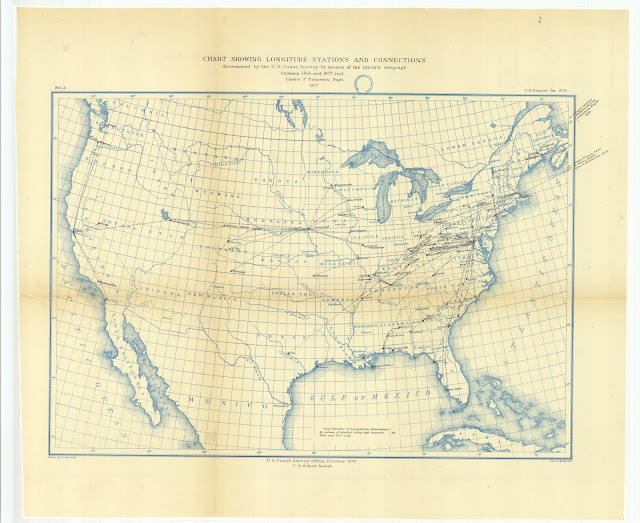On this day in 1844, the first news dispatch telegraph was sent from
Washington D.C. to Baltimore. Coast Survey shortly after adapted this
technology to provide more accurate longitude measurements.
The development of wireless telegraph time signals in the early 20th century, used in combination with marine chronometers, put a final end to the use of lunar distance tables.
This chart shows the connections established over the next few decades.
Year : 1878 / publisher : US Coast Survey
The development of wireless telegraph time signals in the early 20th century, used in combination with marine chronometers, put a final end to the use of lunar distance tables.
This chart shows the connections established over the next few decades.
Year : 1878 / publisher : US Coast Survey
From Politico by Andrew Glass
Samuel Morse taps out first telegraphed news item, May 25, 1844
On May 25th, 1844, Samuel Morse first successfully transmitted word
of a House vote from the U.S. Capitol to a newspaper via telegraph.
The
initial dispatch on Morse’s invention ushered in a new era of
up-to-the-minute congressional reporting.
The day before, Morse (1791-1872) opened the world’s first telegraph
line, sending a message to his partner in Baltimore from the old Supreme
Court chamber in the Capitol.
Annie Ellsworth, the young daughter of
Morse’s friend, had chosen the words of the message — “What hath God
wrought?” — from the biblical Book of Numbers.
Using Morse code — a system that assigned a set of dots and
dashes to each letter of the English alphabet — the inventor tapped out
word to the Baltimore Patriot that the House had voted to reject a
proposal that it sit as a Committee of the Whole to debate the formation
of a territorial government in Oregon.
Morse subsequently began selling reports on congressional
business to the Baltimore American for a penny a word.
News outlets
outside Washington, which heretofore had relied on days-old accounts
prepared by “letter writers” in the congressional galleries, marveled at
their newfound access to near-instant communication.
“Space is annihilated,” gushed the Niles Weekly Register, a
Baltimore magazine.
“By the time the result of the vote of Congress is
announced by the speaker in the Capitol, it is known at the Pratt Street
Depot in the city of Baltimore!”
Through private funding, Morse soon extended telegraph
service to Philadelphia and New York, acquiring more news clients.
Meanwhile, small telegraph companies started to connect many cities east
of the Mississippi.
The practice of dispatching trains by telegraph began in
1851, the same year Western Union was founded.
Western Union built its
first transcontinental telegraph line in 1861, mostly along railroad
rights of way.
By 1866, a telegraph line had been laid across the
Atlantic Ocean bed from the United States to Europe.
Subsequent improvements included the development of good
insulation for telegraph wires.
The man behind this innovation was Ezra
Cornell (1807-74), one of the founders of the university in New York
state that bears his name.
Another improvement, by Thomas Alva Edison
(1847-1931) in 1874, was the Quadruplex system, which allowed for four
messages to be transmitted simultaneously using the same wire.
Although the telegraph has fallen out of widespread use in
the 21st century — replaced by telephones, fax machines and the internet
— it laid the groundwork for the communications revolution that led to
these innovations.
Links :
- The problem of longitudes and the promise of telegraphy (Le Verrier—Magnificent and Detestable Astronomer)
- Longitude by Wire
- GeoGarage blog : Farewell Greenwich Mean Time / Opinion: How the Prime Meridian changed the world

No comments:
Post a Comment